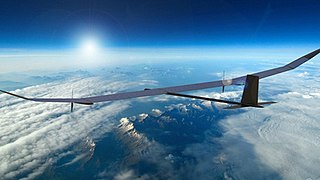 W
WAtmospheric satellite or pseudo-satellite is a marketing term for an aircraft that operates in the atmosphere at high altitudes for extended periods of time, in order to provide services conventionally provided by an artificial satellite orbiting in space.
 W
WThe Airbus Zephyr is a series of lightweight solar-powered UAV.
 W
WThe BAE Systems Persistent High Altitude Solar Aircraft (PHASA-35) is a High-Altitude Long Endurance (HALE) unmanned aerial vehicle (UAV) developed by BAE Systems in collaboration with Prismatic. Designed as a cheaper alternative to satellites, the aircraft can be used for surveillance, border control, communications and disaster relief with a potential ability to stay airborne for up to 12 months. Developed in less than two years, the aircraft carried out its first flight in February 2020 and further trials are currently ongoing.
 W
WThe Boeing A160 Hummingbird is an unmanned aerial vehicle (UAV) helicopter. Its design incorporates many new technologies never before used in helicopters, allowing for greater endurance and altitude than any helicopter currently in operation.
 W
WThe Boeing Phantom Eye was a high altitude, long endurance (HALE) liquid hydrogen-powered unmanned aerial vehicle developed by Boeing Phantom Works. The aircraft was Boeing's proposal to meet the demand from the US military for unmanned drones designed to provide advanced intelligence and reconnaissance work, driven by the combat conditions in Afghanistan in particular. In August 2016, the Phantom Eye demonstrator was disassembled for display at the Air Force Flight Test Museum.
 W
WThe General Atomics ALTUS is an unmanned aerial vehicle, designed for scientific research, built by General Atomics Aeronautical Systems (GA-ASI).
 W
WThe Guizhou Soar Dragon, military designation WZ-7, is an unmanned aerial vehicle of the High-Altitude Long Endurance (HALE) type, featuring an unusual joined, tandem wingplan. As of 2011 it is being developed by the People's Republic of China for reconnaissance and possible anti-shipping missions.
 W
WThe RQ-3 DarkStar is an unmanned aerial vehicle (UAV). Its first flight was on March 29, 1996. The Department of Defense terminated DarkStar in January 1999, after determining the UAV was not aerodynamically stable and was not meeting cost and performance objectives.
 W
WThe Lockheed SR-71 "Blackbird" is a long-range, high-altitude, Mach 3+ strategic reconnaissance aircraft developed and manufactured by the American aerospace company Lockheed Corporation. It was operated by both the United States Air Force (USAF) and NASA.
 W
WThe NASA Centurion was the third aircraft developed as part of an evolutionary series of solar- and fuel-cell-system-powered unmanned aerial vehicles. AeroVironment, Inc. developed the vehicles under NASA's Environmental Research Aircraft and Sensor Technology (ERAST) program. They were built to develop the technologies that would allow long-term, high-altitude aircraft to serve as atmospheric satellites, to perform atmospheric research tasks as well as serve as communications platforms. It was developed from the NASA Pathfinder Plus aircraft and was developed into the NASA Helios.
 W
WThe Northrop B-2 Spirit, also known as the Stealth Bomber, is an American heavy strategic bomber, featuring low observable stealth technology designed for penetrating dense anti-aircraft defenses. Designed during the Cold War, it is a flying wing design with a crew of two. The bomber can deploy both conventional and thermonuclear weapons, such as up to eighty 500-pound class (230 kg) Mk 82 JDAM Global Positioning System-guided bombs, or sixteen 2,400-pound (1,100 kg) B83 nuclear bombs. The B-2 is the only acknowledged aircraft that can carry large air-to-surface standoff weapons in a stealth configuration.
 W
WThe Scaled Composites Model 281 Proteus is a tandem-wing High-Altitude Long Endurance aircraft designed by Burt Rutan to investigate the use of aircraft as high altitude telecommunications relays. The Proteus is actually a multi-mission vehicle, able to carry various payloads on a ventral pylon.